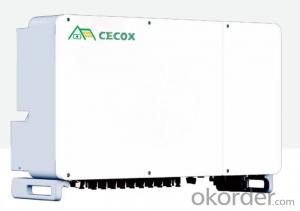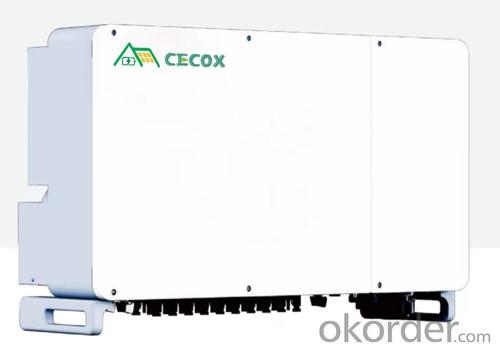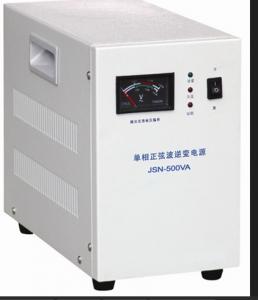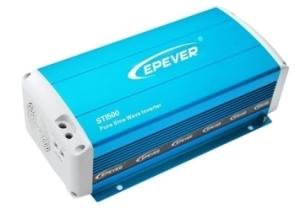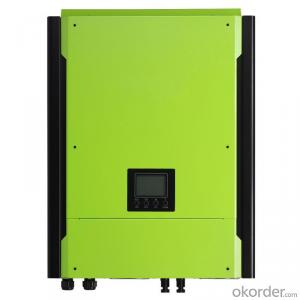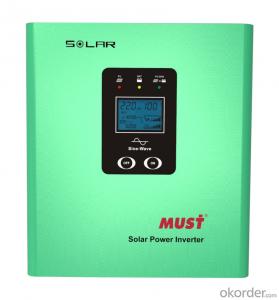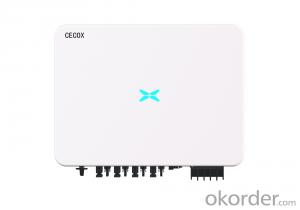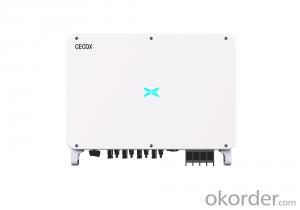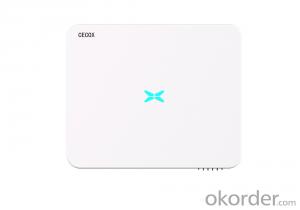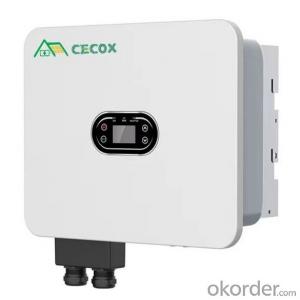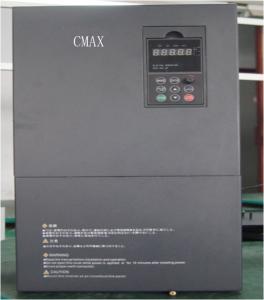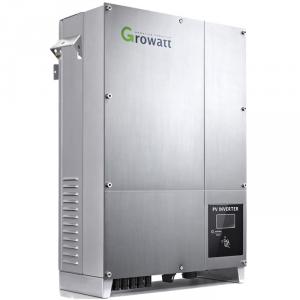100-136kW Three Phase On-Grid Solar Inverter Package
- Loading Port:
- China main port
- Payment Terms:
- TT OR LC
- Min Order Qty:
- 1 unit
- Supply Capability:
- 50 unit/month
OKorder Service Pledge
OKorder Financial Service
You Might Also Like
Specification
Efficient power generation, higher returns
9-12 MPPT, single tracking accuracy is high, dynamic response speed is fast, higher power generation
1.5x DC supermatch
Maximum efficiency %, wide voltage range (180-1000V), early start and late stop, more durable power generation
Suitable for high current components
Intelligent protection operation and maintenance is simple
Intelligent IV diagnosis can accurately locate string faults and proactively find problems
Support fault recording, real-time observation and recording of inverter AC voltage and current waveform, quickly locate problems
Support RS485 (WiFi/DRM/ Bluetooth optional), mobile phone/computer intelligent monitoring, anytime and anywhere more convenient operation
Safe and reliable, comprehensive Warranty
IP66 high protection, support outdoor installation
AC-DC secondary lightning protection, actively eliminate lightning hazards
DC arc detection (AFCI) function is optional, accurately distinguish arc signal, fast shutdown, avoid fire
IEC/EN 62109-1/2, IEC/EN 61000-6-1/3, IEC/EN 61000-6-2/4, EN50549, IEC61727/IEC62116, CEI 0-21/CEI 0-16, C10/C11, VDE 4105, VDE 0124, G99, RD244, UNE217001, UNE217002, NC RfG, TOR Erzeuger, NRS097-2-1, NB/T 32004
Night power consumption <1W
Size:1050 x 660 x 330 mm
Weight:95/98/101kg(100KW/110KW/136KW)
Quality Warranty:5-10 years
- Q: How does a solar inverter handle overloading?
- A solar inverter handles overloading by constantly monitoring the power output from the solar panels. If the demand for electricity exceeds the maximum capacity of the inverter, it automatically reduces the power output to a safe level. This prevents the inverter from getting damaged and ensures a stable and reliable power supply.
- Q: Can a solar inverter be used with a solar-powered greenhouse system?
- Yes, a solar inverter can be used with a solar-powered greenhouse system. A solar inverter is necessary to convert the direct current (DC) electricity generated by the solar panels into alternating current (AC) electricity that can be used to power the various components of a greenhouse system, such as fans, lighting, and irrigation systems.
- Q: How does a solar inverter handle varying solar irradiance levels?
- A solar inverter handles varying solar irradiance levels by continuously monitoring the incoming solar power and adjusting its output accordingly. It employs a maximum power point tracking (MPPT) algorithm that optimizes the energy conversion from the solar panels to the desired AC power output. When solar irradiance levels fluctuate, the inverter dynamically adapts to ensure the maximum power is extracted from the solar panels. This allows for efficient energy conversion and maximum utilization of the available solar power.
- Q: What is the role of a solar inverter in a grid-tied system?
- The role of a solar inverter in a grid-tied system is to convert the direct current (DC) electricity produced by the solar panels into alternating current (AC) electricity that can be used by the electrical grid or consumed by the appliances and devices in a home or business. It also ensures that the solar energy generated is synchronized with the grid's voltage and frequency to enable efficient and safe transfer of power. Additionally, the solar inverter monitors and controls the flow of electricity between the solar panels, the grid, and any energy storage systems that may be connected to the system.
- Q: What is the role of a solar inverter in a microgrid system?
- The role of a solar inverter in a microgrid system is to convert the direct current (DC) electricity generated by solar panels into alternating current (AC) electricity that can be used to power the various loads within the microgrid. It also manages the flow of electricity between the microgrid and the utility grid, allowing for bidirectional power flow and enabling the system to operate in both grid-connected and islanded modes. Additionally, the solar inverter ensures the stability and quality of the electricity supply, regulating voltage and frequency levels to match the requirements of the microgrid.
- Q: What are the advantages of using a solar inverter with battery storage?
- There are several advantages of using a solar inverter with battery storage. Firstly, it enables the storage of excess solar energy generated during the day, which can be utilized during the night or during periods of low solar generation. This allows for greater self-consumption of solar energy and reduces reliance on the grid, resulting in potential cost savings on electricity bills. Additionally, solar inverters with battery storage provide backup power during power outages. The stored energy in the batteries can be used to power essential appliances and devices, ensuring uninterrupted electricity supply. Furthermore, using a solar inverter with battery storage promotes energy independence and sustainability. By storing and using solar energy, individuals can reduce their carbon footprint and contribute to a cleaner environment. It also provides flexibility in energy management, as users can choose when to draw energy from the grid or from the batteries, depending on the energy rates or their specific needs. Overall, integrating battery storage with a solar inverter offers increased energy efficiency, cost savings, backup power, and environmental benefits, making it a compelling solution for residential and commercial solar installations.
- Q: Can a solar inverter be used with solar concentrators?
- Yes, a solar inverter can be used with solar concentrators. Solar concentrators focus sunlight onto a smaller area, increasing the intensity of the light. The solar inverter's primary function is to convert the DC power generated by the solar panels into AC power suitable for use in homes or businesses. Therefore, it can still be used to convert the enhanced DC power generated by solar concentrators into usable AC power.
- Q: How does a solar inverter handle voltage flicker?
- A solar inverter handles voltage flicker by constantly monitoring the grid voltage and adjusting its output to maintain a stable voltage. It uses advanced control algorithms to quickly respond to fluctuations and minimize the impact of voltage flicker on the connected devices.
- Q: Are there any voltage or frequency regulations for solar inverters?
- Yes, there are voltage and frequency regulations for solar inverters. These regulations vary from country to country and are typically set by regulatory bodies or standardization organizations. In most countries, solar inverters must comply with specific voltage and frequency limits to ensure the safe and reliable operation of the electrical grid. Voltage regulations specify the allowable range of output voltage that a solar inverter can provide to the grid. This ensures that the voltage remains within acceptable limits to prevent overvoltage or undervoltage conditions that could damage electrical equipment or disrupt the grid's stability. The specific voltage limits depend on factors such as the type of grid system (e.g., single-phase or three-phase) and the voltage levels used in the country. Frequency regulations, on the other hand, define the acceptable range of output frequency that a solar inverter can provide to the grid. Grid frequency is typically set at a specific value (e.g., 50 Hz or 60 Hz) and solar inverters must synchronize their output frequency with the grid to ensure compatibility. Deviations from the specified frequency can lead to issues such as equipment malfunction or instability in the grid. Compliance with voltage and frequency regulations is crucial for solar inverters to ensure the proper integration of renewable energy sources into the electrical grid. In many countries, solar inverters must adhere to specific technical standards or certifications to demonstrate their compliance with these regulations. These standards often cover various aspects of inverter performance, including voltage and frequency control, power quality, and grid interaction.
- Q: What is the role of a solar inverter in a solar-powered desalination system?
- The role of a solar inverter in a solar-powered desalination system is to convert the direct current (DC) generated by the solar panels into alternating current (AC) that can be used to power the desalination equipment. It ensures the efficient utilization of solar energy by transforming it into a usable form for the desalination process.
Send your message to us
100-136kW Three Phase On-Grid Solar Inverter Package
- Loading Port:
- China main port
- Payment Terms:
- TT OR LC
- Min Order Qty:
- 1 unit
- Supply Capability:
- 50 unit/month
OKorder Service Pledge
OKorder Financial Service
Similar products
Hot products
Hot Searches
Related keywords
